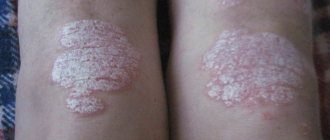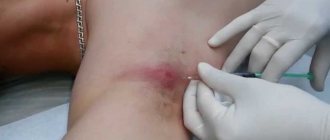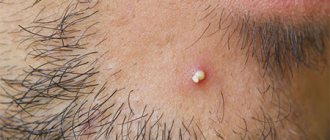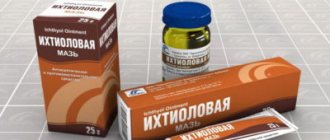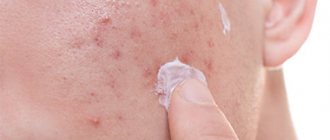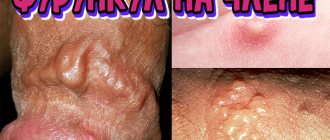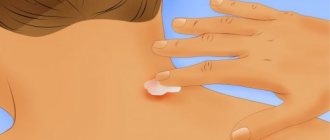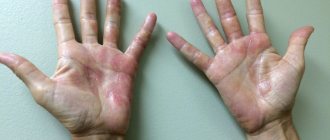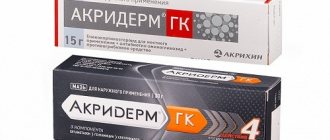What is a carbuncle
A carbuncle is almost the same as a boil, but it affects the subcutaneous fatty tissue. The difference is that a large area of inflammation forms on the body, which over time becomes plum-colored. It greatly affects the general condition of the body. Lethargy, headaches and muscle pain appear, and the temperature rises.
How does a boil develop?
A furuncle is a focus of acute purulent-necrotic lesion. It develops in the hair follicle and spreads to the dermis and subcutaneous fat tissue.
First, a subcutaneous capsule the size of a millet grain appears at the mouth of the follicle, filled with lymphatic or bloody contents. The activation of pathogenic microorganisms is accompanied by severe itching that occurs on the surface of the skin in the area of the affected hair follicle.
The process is developing rapidly. Over the course of 1-2 days from the moment the bacteria penetrate, the capsule increases in size. A painful area of increased density appears around it.
The boil opens on day 5-7
The surface of the skin in the affected area turns red. The dimensions of the capsule can reach impressive sizes - up to several centimeters. The pain in the affected area is so severe that it is difficult for the person to move. The lymph nodes located next to the abscess increase in size and become painful. Body temperature may rise.
On the 3-4th day of development of the process, the capsule appears on the surface, and the boil “ripens”. At this stage, its contents become purulent. As the capsule grows, neighboring tissues melt. Their dead cells are part of its purulent mass.
On days 5-7 after the first signs of the pathological process appear, the boil opens. The capsule bursts and purulent fluid flows out of it. Later, the purulent core is exposed. It is a compacted purulent exudate. The rod is rejected by healthy tissues. In its place there remains a cavity (fistula tract).
After the purulent contents are rejected, the redness on the skin decreases. The pain quickly decreases and completely disappears already on the 2nd day after opening. When the wound heals, a scar remains in its place. The size of the scar corresponds to the size of the capsule with purulent contents.
A purulent inflammatory process can develop in any hair follicle. Boils appear more often in the armpits, in the buttocks, on the abdomen, and on the inner and outer thighs. They can appear on the scalp and even in the ear - wherever there are hairs.
Etiology
The main cause is Staphylococcus aureus. This is a microorganism that causes diseases such as boils, carbuncles, phlegmon of the face and neck, and skin abscess. But changes can only appear if certain factors are present that promote infiltration. And with reduced immunity, multiple lesions, furunculosis or skin abscess occur. There is no way to hide boils or carbuncles on the face; they attract the attention of others. Therefore, it is necessary to avoid the main causes that may contribute to the rapid development of the defect.
Causes of appearance, development and symptoms
The most common “culprit” for the development of boils is Staphylococcus aureus. This pathogen exists on the skin of most people without causing harm to the body in an inactive state. Any scratch or cut can cause a boil: the immune system reacts to the injury and sends white blood cells to the affected area, which fight bacteria. As a result, dead microorganisms and immune cells begin to accumulate in one of the areas, which provokes the formation of pus. The main factors for the appearance of boils are:
- In boys, as they grow up, a hormonal imbalance occurs in the body, the skin becomes oilier, which encourages the development of bacteria;
- close contact with a person who has a boil;
- violation of personal hygiene rules;
- active sports, as a result of which constant friction of the outer integument occurs and the activity of the sweat glands increases;
- unsanitary conditions;
- the presence of other skin diseases (dermatitis or scabies);
- excess weight.
A boil can develop in a completely healthy person. If the disease relapses, you should be examined in a hospital for hepatitis, diabetes and other diseases.
The clinical picture of boils is well differentiated from other dermatological pathologies. 2-3 days before the formation of an abscess, the patient notices itching, increased local temperature and twitching pain. Then an inflammatory infiltrate and painful cone-shaped abscesses appear.
Causes
Boils (carbuncles) are a consequence of the characteristics of the individual and a decrease in the immune complex.
The reasons for their development may be:
- diabetes;
- pathology of the endocrine system;
- decreased immunity;
- untreated and chronic infections;
- suppression of immune function while taking cytostatics;
- long-term use of antibacterial drugs;
- neoplasms;
- skin injuries, cuts, scratches;
- unbalanced diet.
Provoking factors for the development of pyoderma
Provoking factors are:
- skin contamination (especially as a result of contact with grass);
- excessive dry skin;
- regular exposure of the skin to chemical or temperature irritants.
Excessive dry skin provokes the development of diseases
Endocrine diseases and hormonal disorders can weaken the skin's protective barrier.
Stressful situations, chronic fatigue (physical and mental), frequent poisoning, chronic diseases of the digestive system, internal foci of purulent infection, immune imbalance, and, in addition, unbalanced nutrition, leading to a lack of vitamins and minerals, have a detrimental effect on the body's defenses.
Serious metabolic disorders reduce the body's resistance to bacterial agents.
The risk of infection increases in people with diabetic changes in blood vessels and trophic disorders associated with diabetic polyneuritis. Therefore, in people suffering from diabetes, pyoderma develops rapidly and causes serious complications.
The risk of infection is higher in people who have broken skin or suffer from itchy skin.
General symptoms
A purulent compaction is characterized by swelling of the surrounding tissue and has a reddish tint. Due to the development of the inflammatory process, symptoms of malaise appear, which determine a person’s energy. But it is difficult for a non-specialist to distinguish a carbuncle from a boil. It is important to know that several boils in a small area form a carbuncle. Its therapy requires specialized medical care. When you press on purulent-necrotic rashes, the nagging pain becomes much stronger.
Stages of development (forms)
All boils and carbuncles develop naturally, going through 4 stages. Each has its own characteristics.
- Infiltrative. Its duration depends on the characteristics of the patient’s immunity. On average it lasts 3 days. It is characterized by redness, pain, and swelling around the tubercle.
- Suppuration and necrosis. The duration is about a week. The stage ends with the pus breaking out. During this period, high fever, severe jerking pain, weakness and malaise are observed.
- Regeneration (healing). A healing period begins after the pus breaks through and comes out. The pain becomes less noticeable. In place of the abscess, a pothole forms, which is filled with granulation tissue. The whole process takes up to 5 days.
- Completion stage. At this stage, the wounds become scarred. At first the scar is reddish, but over time it becomes lighter and is barely visible.
And depending on the stage, infiltrative (spreading to adjacent tissues) and abscessive (local) forms are distinguished.
What is the difference between a carbuncle and a boil?
A boil or boil differs from a carbuncle in size and texture. A furuncle, due to the fact that one hair follicle is inflamed, occupies a significantly smaller area than a carbuncle. In addition, the latter affects fatty tissue, so the bags of pus lie deeper, and there can be several of them.
Causes
The reasons why boils occur are infections that enter the body. Any abrasion or scratch is an open gate for a wide variety of pathogenic microbes to enter the body. If a person’s immunity is weakened, then the likelihood of infection with staphylococcus increases.
The difference between a boil and a carbuncle becomes obvious if you pay attention to the number of foci of inflammation in one small area. If there are several of them and they are quite deep, it means that you have to deal with a carbuncle. It happens that purulent inflammations occur simultaneously in different parts of the body. In this case, the disease is called furunculosis.
Structure of an abscess
Carbuncles and boils differ in appearance. A carbuncle consists of several follicles merged in one small area, with a common inflamed tissue, several expressive foci of necrotization, and deeply located ulcers that involve fatty tissue in the process. Locations: armpits, buttocks, neck, head, face.
In a boil, inflamed tissue is observed only where hair grows, where there is increased sweating or rubbing of the skin with clothing. The area of the affected area is much smaller than in the first case. If a large boil forms, then inflammation of the tissue around it is clearly felt.
Symptoms
Boils and carbuncles have common symptoms. But there are quite a lot of excellent ones to make an accurate diagnosis, since due to the complexity of the course of the first type of disease, it needs to be treated more intensively.
Symptoms of intoxication with carbuncle are very expressive:
- the person has a fever;
- the temperature rises;
- consciousness is impaired;
- the place of origin is almost black;
- characterized by severe, bursting-twitching pain;
- nausea and vomiting are observed.
The carbuncle has several rods in the infection zone, so there will also be a lot of ulcers. To these are added small holes called honeycombs. Pus comes out of them little by little.
When the main ulcers are opened, their contents are greenish-gray in color.
Difference in treatment
The differences between a boil and a carbuncle are in the treatment of these suppurations. So, carbuncle should be treated only in a hospital. Such an extensive lesion must be opened by a surgeon. Today, in addition to the usual scalpel, they also resort to laser removal. This method is not so traumatic and leaves minimal marks on the skin. All manipulations are performed under local anesthesia.
If the carbuncle is located on the head, neck or face, then solid food will have to be put off until recovery; it is better not to talk. Additionally, bed rest is prescribed.
In addition to surgical treatment methods, medications will be needed. They are used after removal of pus to completely eliminate the infection. This includes the prescription of antibiotics, treatment of ulcers with regenerating, antibacterial agents.
Treatment of boils is possible at home. Of course, if the purulent formation is not on the face. If the pain syndrome is severe, it is better to consult a specialist.
To treat purulent inflammations such as boils, you can resort to various means:
- As soon as compaction and redness occur, lubricate the area with alcohol or brilliant green.
- Dry heat will help the abscess to mature faster. Lotions should not be applied, since a humid environment promotes the spread of staphylococcus to neighboring areas.
- To relieve pain, you can take mild painkillers.
- Pharmacy products are also suitable to reduce inflammation.
- If there are several boils, then you cannot do without antibiotics.
In both cases, the issue of improving immunity is relevant.
Thus, the difference between a boil and a carbuncle lies in the external manifestations of these diseases, different symptoms, and different approaches to treatment.
Treatment tactics
The rapid healing of a purulent-necrotic lesion is facilitated by the use of antibiotics, because a new infection can enter an unclosed, self-ruptured wound. Therapy should be selected depending on the severity of the inflammatory process. In this case, the use of broad-spectrum antibacterial drugs is mandatory in order to eliminate the etiological factor of the abscess - Staphylococcus aureus. The use is also appropriate for reducing fever and the general intoxication process. When the painful area has disappeared, do not forget to treat the wound daily with antiseptic solutions until it heals completely. In addition, it is possible to use ointments that promote rapid skin regeneration and contain an antibiotic.
What is used in the treatment of purulent-inflammatory skin pathologies?
- toxoids and bacteriophages of staphylococcus;
- enzymes that help reject necrotic masses;
- antiseptic solutions, washing with disinfectant gel;
- local therapy using antibacterial ointments, for example, Levosin.
Thermal procedures on the surface of the inflammatory focus will help to quickly go through all stages of development of the abscess. At the same time, simply following antiseptic rules will protect against infection with new bacteria. During illness, it is worth changing your diet. The diet should contain a sufficient amount of B vitamins, as well as antioxidants.
If a purulent focus often recurs in one place, then this is a chronic inflammation of the skin. This involves a diagnostic search for the occurrence of inflammatory infiltrates through a full examination of organs and systems.
Possible complications
Treating carbuncles is much more difficult than a single boil. The likelihood of developing complications is also much higher, especially in ulcers that appear on the back (tendency to form phlegmon) and on the face.
Large boils on the face and back of the head are difficult for patients to tolerate. Multiple boils or large ulcers located under the nose, above the upper lip, near the external auditory canal, provoke severe throbbing pain.
Abscesses in an intimate place in men, in the scrotum area, cause severe swelling, which is explained by the structure of the tissue. The consequences of untimely treatment of boils and carbuncles include:
- thrombophlebitis, most often a complication observed in patients with diabetes;
basal meningitis, occurs as a result of pus entering the blood vessels supplying the brain; Abscesses in the nasolabial triangle are very dangerous;
- sepsis requiring blood transfusion;
- soft tissue abscess;
- septic arthritis, when the infection spreads deep into the body, affecting the joints;
- lymphadenitis (if a bacterial infection affects the lymph nodes);
- disturbances in the functioning of the heart.
Special diagnostics are usually not required to determine the type of abscess. Furuncle and carbuncle have clear distinctive features. Mandatory tests when examined by a dermatologist include:
- bacteriological analysis of the purulent contents of the abscess;
- blood test for infection;
- determination of glucose levels.
The source of infection after bacterial culture becomes known after 3-5 days, but doctors prescribe treatment for boils and carbuncles without waiting for results, relying on clinical experience.
During treatment you must follow the following rules:
The patient is given a separate towel and bed linen, since the disease is contagious.
- Touching the abscess is minimized; after contact with abscesses, be sure to wash your hands with soap.
- If possible, a bandage of gauze or sterile bandage is attached over the abscess to speed up the healing process.
In case of furunculosis, before opening the abscess, it is forbidden to use Vishnevsky ointment or any antibacterial ointment - the composition of the drugs contributes to the spread of infection deep into the skin.
When surgery is unavoidable
If the abscess does not break through for a long time, the body temperature is above 39°C, complications arise and drug therapy does not help, then surgical intervention in a hospital is necessary.
Opening the cavity of a carbuncle or boil takes place under local anesthesia using the hands of a surgeon and a scalpel. You should not try to remove the necrotic core from the wound crater on your own at home. Self-medication can lead to serious consequences (lymphangitis, phlegmon). The site of the future incision is injected with an anesthetic medication, for example, Novocaine or Ultracaine. Afterwards, the abscess is opened and the rod is removed, as well as the wound is cleaned of dead tissue.
After opening, a deep wound (funnel) forms on the skin. For its rapid healing, the following ointments are used: tetracycline, Levosin, Dimexide. They help the rapid formation of granulation tissue at the site of the funnel. In addition, antibiotics are prescribed - Ceftriaxone, Cefotaxime. In stationary conditions, wound dressings are performed.
IMPORTANT! Surgical opening of the boil or carbuncle is the most recent option of all treatment methods. It is used only when conservative treatment has failed. It is worth understanding that after surgery a scar remains on the skin.
Traditional methods
Alternative medicine accelerates the process of maturation of a carbuncle or boil and helps relieve pain.
Recipes from traditional healers are allowed to be used in mild stages of dermatological disease and only under the supervision of the attending physician.
Baked onion
The recipe makes the carbuncle ripening process faster and also produces an antibacterial effect.
The oven should be preheated to 180°C. Place the onion, cut in half, on a baking sheet, cut side down, and leave for 5 minutes. The slightly cooled baked vegetable must be applied to the carbuncle or boil, secured with a band-aid, and wrapped in a warm cloth or scarf. Keep it on for 2 hours, then change the bandage. The procedure must be carried out 6 times a day until the boil breaks through.
Rye flour with honey
To prepare, you will need 100 g of honey, laundry soap (72%) and rye flour. The soap must be grated and melted in a water bath, then mixed with honey, gradually add flour until the consistency of an elastic cake. Apply the resulting dough to the boil (carbuncle), wrap it in cling film or polyethylene and leave overnight. The procedure is carried out until the boil breaks and pus comes out.
Indoor ficus
One leaf of the plant must be twisted through a meat grinder, and the second one must be immersed in boiling water until softened. Place the pulp obtained from the first leaf on the second, apply to the carbuncle, fix and leave overnight. The manipulation must be repeated until the pus comes out.
